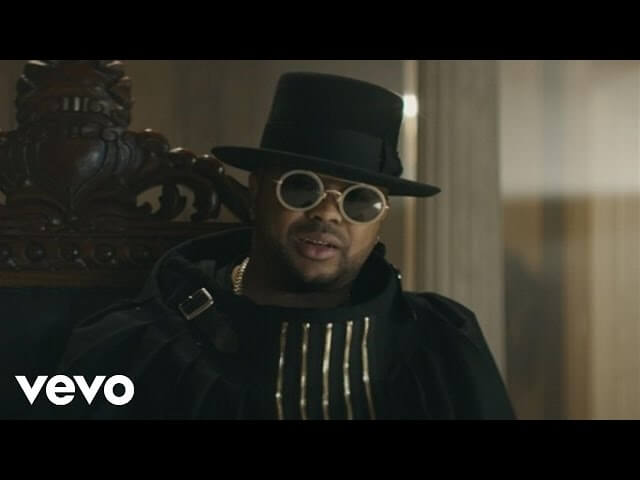The-Dream is a complicated pop genius

Last Tuesday, Terius “The-Dream” Nash, one of the most important figures in the past decade of pop music–the guy who helped to bring “Single Ladies,” “Umbrella,” and Justin Bieber’s “Baby” into the world–released the first half of a diptych of EPs, entitled Crown. (The second half, Jewel comes out July 7.) The general listening audience’s reaction was about the same as it’s been for every one of Nash’s releases since 2009’s Love Vs Money: ecstasy from his smallish but intensely devoted fan base and near-total indifference from the rest of the world. Its lead single “That’s My Shit,” the EP’s best shot at a radio hit, failed to make much of an impact on Billboard’s R&B/Hip-Hop Airplay chart. Why can’t one of the most successful songwriters of our time catch a break these days?
It’s not because he’s lost his gift for writing hit songs. He’s co-written and/or co-produced most of Beyoncé’s standouts from the past few years, including “Flawless,” “Countdown,” and “Love On Top.” Last year he took home his fifth Grammy for his writing contributions to Jay Z and Justin Timberlake’s “Holy Grail.” And it’s not because he’s lost his voice, which is still the transcendentally baby-smooth tenor it was when he dropped his first and only unqualified pop crossover hit “Shawty Is A 10” in 2007.
The most likely explanation is that most people can’t handle Terius Nash without a filter. One of the most successful members of pop’s Illuminati, he’s also probably the most eccentric, no matter how out-there Pharrell gets with his haberdashery. Nash (along with his frequent production and songwriting partner Christopher “Tricky” Stewart) has spent his entire career balancing his talent for writing universally appealing hooks with an experimental side that appears to require massive amounts of star power to sell to a mainstream audience. Think of the surreally escalating key changes in “Love On Top” or the juxtaposition in “Single Ladies” of a ridiculously catchy vocal part and what Sasha Frere-Jones of The New Yorker called a “swell of weird, dark synthesizers that don’t seem to know about the party going on in the rest of the song.” Without Beyoncé to anchor it, most people probably aren’t willing to devote the energy required to keep up with what’s going on in a track like Crown’s “Cedes Benz,” which shifts rapidly between trap rap, synthesized hard rock, Houston-style chopped-and-screwed beats, and satiny throwback soul.
Nash’s filterlessness also applies to his lyrics. With other artists he’s capable of writing paeans to puppy-dog love on par with anything that ever came out of the Brill Building. When he’s on his own he tends to let his id take the wheel, and things can get uncomfortably real. “Used To Be” from 1977, the mixtape he released under his given name in 2011, is a five-minute-long dirge in which he lists every petty failing he sees in a romantic partner. (“[You] used to be anti-internet / But now you’re constantly blogging and shit.”) “That’s My Shit”’s lackluster chart performance probably isn’t because of the effervescent melody or summer-ready beat, but because the lyrics involve eye-popping detailed description of the torrid affair Nash conducts with the girlfriend of an unspecified “you.” This seems like a perfectly designed way to provoke the egos of straight male listeners and turn them against your song.
The same eccentricities that get Nash into trouble sometimes are also, when they sync up properly, what make him one of the most interesting pop performers of the moment, even if the size of his audience doesn’t correspond. Two good examples involve weddings. 1977’s “Wedding Crasher” takes the slapstick lyrical conceit of Nash getting wasted on Patron and crashing an ex’s wedding to proclaim his love for her and gives it an unexpectedly weighty poignancy through its delicately bittersweet melody. In “Wedding Bells,” from the Royalty: The Prequel EP Nash self-released online last year, Nash delivers a marriage proposal that reads like a list of reasons why nobody should ever marry Terius Nash (including his numerous previous marriages and the fact that both parties’ families agree that they’d be a terrible match) over a beat that’s part-nuptial and part-strip club.
Judging by the timing, “Wedding Crasher” was very likely written when Nash’s ex-wife, the singer Nivea, was engaged to Lil Wayne. “Wedding Bells” came out four days after Nash married his third wife, effectively completing his matrimonial “hat trick,” as he casually refers to it in the song. Both not only describe but potently evoke, in their own idiosyncratic ways, wild emotional impulses that most of us have felt. Who hasn’t wanted to attempt a badly thought-out plan to win back an ex we haven’t gotten over? Or to say fuck it and get married just because it felt right at the moment? The-Dream’s catalog may be messy, but sometimes that’s what makes it so great.